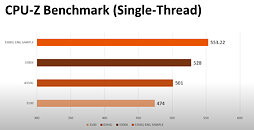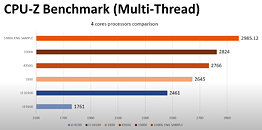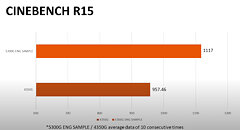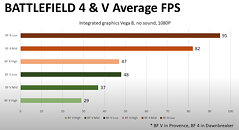Monday, March 15th 2021

AMD Ryzen 5 5300G Engineering Sample Benchmarked
The Ryzen 5 5300G is a rumored upcoming Zen 3 APU from AMD which has recently been spotted in engineering sample form. The new processor was recently listed on eBay with designation 100-000000262-30_Y, and while the processor is now sold out it has already been benchmarked and detailed. The Ryzen 5 5300G is the successor to the OEM exclusive Ryzen 3 4300G and consumer Ryzen 3 2300G processors and should offer significant performance improvements with the introduction of Zen 3 cores. The 5300G includes four cores and eight threads with a potential 3.5 GHz base clock and no reported boost clocks however this is subject to change with the official release.
The processor was put to the test with CPU-Z single-threaded performance showing the CPU bringing a 10.4% improvement over the 4300G while in multi-threaded bringing a 7.9% uplift. In Cinebench R15 the 5300G beats the Ryzen 3 Pro 4350G by 16.7% and the Intel Core i3-10100 by 11.6%. We only got two gaming benchmarks for Battlefield 4 and Battlefield V with the processors onboard Vega graphics performing admirably in both providing 29 FPS in Battlefield V at 1080p high settings. When played with less demanding graphics settings or with older games we see some impressive numbers with up to 95 FPS on Battlefield 4 at 1080p low settings.
Sources:
eBay, Hugo
The processor was put to the test with CPU-Z single-threaded performance showing the CPU bringing a 10.4% improvement over the 4300G while in multi-threaded bringing a 7.9% uplift. In Cinebench R15 the 5300G beats the Ryzen 3 Pro 4350G by 16.7% and the Intel Core i3-10100 by 11.6%. We only got two gaming benchmarks for Battlefield 4 and Battlefield V with the processors onboard Vega graphics performing admirably in both providing 29 FPS in Battlefield V at 1080p high settings. When played with less demanding graphics settings or with older games we see some impressive numbers with up to 95 FPS on Battlefield 4 at 1080p low settings.




31 Comments on AMD Ryzen 5 5300G Engineering Sample Benchmarked
I have a DDR4-3200 4700U at work and a DDR4-2400 2700U at home. I run Unigine Superposition at 1080pMed preset last night and got 1900 points. The 4700U just got 2050 points this morning.
As far as I'm concerned the poor old 2700U is damn close to the 4700U despite the 4700U having 50% more bandwidth. Whilst the LPDDR4X variants are faster, they're not that much faster and if there was a absolute memory bottleneck, Vega8 would perform no better at all - but it's significantly better, even on DDR4-3200.
1) The memory bottleneck does play a small role in the graphics performance, otherwise the LPDDR4X variants at the same cTDP would be no quicker at all. They are up to 10-15% faster for a dual-channel setup.
2) There is an enormous amount of scope for improved performance over a vega7 using exactly the same DDR4-3200. The Vega8 in the 4800HS with higher power draw runs circles around the vega7 even though it's an apples-to-apples comparison with identical memory configs.
It's just CUs and how much power it's allowed to use. The old 2700U has 43% more GPU in it.
2700U versus 4700U:
3700U versus 4700U:
Is the 4700U you are using at work running single or dual channel? Are they running at the same TDP? Same cooling setup? Same drivers? I only ask because in just about every game I've seen, the 4700U is ~20-30% faster than the 2700U in iGPU gaming, some of which comes from much higher GPU clocks, some from better memory controllers, but ultimately results in higher performance from the APU.
Regarding the 4700U versus 4800HS, keep in mind more CU's would also increase power consumption, so whilst the 4700U might not be memory bandwidth limited, throwing more CU's at it wouldn't likely increase performance because it is already power limited (and would become more so with more CU's). The 4800HS is clearly able to hold higher clocks which explains the performance increase, so I concede your point on those low-power APU's not being memory bandwidth limited. But from my own experience with the 4650G (with a much higher power limit and clocks), fps increases from faster GPU clocks is definitely plateauing (around 5% performance increase with 20% higher clocks), whereas fps increases with memory clock increases nearly linearly, which tells me at least at 65W desktop APU-level we're hitting memory bandwidth limits. I wouldn't expect a 11CU 4680G hypothetical CPU to perform much better than the 4650G if still coupled to 3200MHz DDR4 memory.
My 2700U is using third-party software to manipulate the balance of power to the IGP over the CPU cores. When I configure my cTDP to 25W, that's probably juicing the IGP up to desktop or HS APU levels - I run the Vega10 at almost 1200MHz, which is far higher than the ~900MHz it'll run with the default behaviour on a 25W BIOS settings. I'm also running CL14 SoDIMMs which is unheard of for most laptops. The Thinkpad I have at work is dual-channel DDR4, not sure on the TDP, but given it's a thin-and-light it's probably 15W. Either way I know the RAM is sloppy OEM timings at CL22 and no way to improve them.
So yeah, this isn't a 2700U vs 4700U discussion, as in apples-to-apples comparisons, the 4700U will be better for sure.
No, the point I'm trying to make is that my 2700U proves that there is scope even on older tech and older process nodes, there's plenty of scope to get much more performance out of the integrated graphics cores than AMD currently bothers with. There is clearly room for more performance with limited memory bandwidth (my DDR4-2400) and there's clearly scope to get faster APU graphics at higher TDPs. As someone who does light gaming on my 2700U, I do not need CPU performance. One or two threads at 1.6GHz is plenty and the rest of the power budget gets spent on the Vega cores. The fact that Intel and Nvidia have worked out dynamic balancing between CPU and GPU power consumption and AMD haven't is kind of sad. The fact I need to resort to third-party software to juice up my Vega10 and stop the CPU cores from wasting all the power budget on frivolous and pointless boosting at any given cTDP is sad.
- The width of the IGP (how many Vega CUs) matters the most. Even older models can perform well when juiced up with enough power to hit higher clocks.
- Memory bandwidth comes next; Dual channel, low-latency preferred because higher framerates and resolutions aren't possible without it.
- cTDP comes next - because even a narrow Vega5 in a Ryzen3 4300U can clock high enough to outperform Vega8 or Vega10 models that are throttled to low clockspeeds by limited single-fan coolers.
- Finally, your configuration of that CPU can have further effects. Even at high cTDPs like 65W desktop models, the CPU can consume the lion's share of the power budget at times unless you use a utility to limit the CPU cores from boosting too high, and pulling too much of that cTDP away from the IGP.
If you look at sites like notebookcheck.de it's very hard to get an idea of how well each model of Ryzen performs because the memory and cTDP have such a huge impact on how well an AMD APU performs in games.